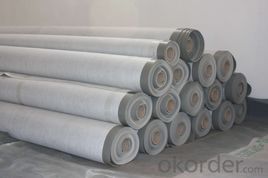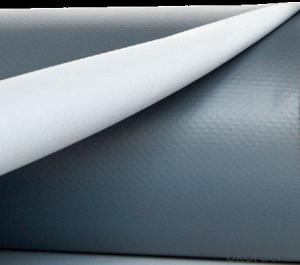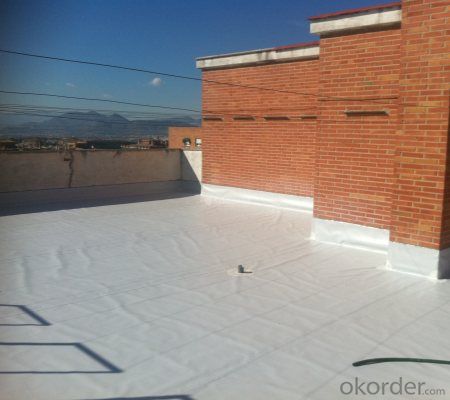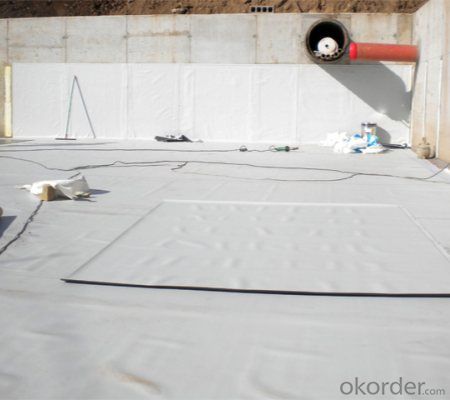PVC Membrane of Polyester for Waterproof System
- Loading Port:
- Qingdao
- Payment Terms:
- TT OR LC
- Min Order Qty:
- 8000 m²
- Supply Capability:
- 100000 m²/month
OKorder Service Pledge
OKorder Financial Service
You Might Also Like
PVC Membrane of Polyester for Waterproof System
Description Of PVC Membrane of Polyester for Waterproof System
1. PVC Membrane Reinforcement fo Polyester is made from PVC and poliester , which is for waterproofing of exposed and non-exposed applications,adopts the world-advanced equipment of cold feeding extrusion and continuous vulcanization technology, is of high elasticity among high polymer waterproof materials and becomes a world-popular waterproofing material.
Main Features of PVC Membrane of Polyester for Waterproof System
1. Excellent physical and mechanical performance
2. High tearing resistance
3. Good deformation adaptability
Specifications of PVC Membrane of Polyester for Waterproof System
Material | PVC |
Size | 1.2m (width)*20m (length) or customized, weldable type 2.05m |
Thick | 1.2mm, 1.5mm, |
Pattern | Non-reinforced (homogeneous) |
Certificate | ISO9001/14001 |
Applications of PVC Membrane of Polyester for Waterproof System
1. Industrial and civil building waterproofing
2. Geosynthetic liner for swimming pool, channels, irrigation system
IMages of PVC Membrane of Polyester for Waterproof System



FAQ:
1. What are we supplying?
We are specialized in producing Colorful Asphalt Roof Shingle, SBS/APP modified bitumen waterproof membrane, Self adhesive bitumen waterproof membrane, PVC waterproofing membrane, Single Component Polyurethane Waterproof Coating, and Spray Polyurea Waterproof Coating
.
2. How Many years experience do we have?
We have been exported to more than 15 countries in the past 12 years.
3. How long do we usually reply your request?
We always reply our customer within 4 hours.
- Q: Can a waterproofing membrane be walked on?
- Walking on a waterproofing membrane is possible, but it depends on the type of membrane and its intended use. Some waterproofing membranes, like those used in roofing, are designed to withstand foot traffic without damage. These membranes are durable and can be walked on during installation and maintenance. However, it is crucial to follow the manufacturer's guidelines to ensure the membrane remains intact and provides effective waterproofing. On the other hand, certain types of below-grade waterproofing membranes may not be suitable for walking on as it could compromise their performance. It is advisable to consult a professional or refer to the manufacturer's instructions to determine if walking on a specific waterproofing membrane is safe and appropriate.
- Q: Does a waterproofing membrane require any special considerations for installation in earthquake-prone areas?
- Installation of a waterproofing membrane in earthquake-prone areas necessitates special considerations. The ground in these regions is more susceptible to movement and shaking, which can greatly impact the integrity of the waterproofing system. Therefore, it is crucial to take additional precautions to ensure that the membrane is installed properly and capable of withstanding seismic activity. One important factor to consider is the choice of the waterproofing membrane itself. It is advisable to select a membrane that has been specifically designed and tested to endure seismic activity. These membranes are typically more flexible and possess higher tensile strength to accommodate ground movement during earthquakes. Moreover, the installation process should be executed with utmost care and attention to detail. The membrane should be securely anchored or fastened to the substrate using appropriate fasteners and adhesives. Reinforcement techniques, such as using reinforcing fabric or mesh, can also be employed to enhance the membrane's resistance to movement. Additionally, it is essential to ensure that all seams and joints in the membrane are adequately sealed and reinforced. Special attention should be given to areas that are more prone to movement, such as corners, edges, and penetrations. Utilizing compatible and high-quality sealants or adhesives will assist in maintaining the integrity of these vulnerable points. Regular inspections and maintenance are also critical in earthquake-prone areas. Periodically inspecting the membrane for any signs of damage, such as cracks or separations, allows for early detection and timely repairs. Additionally, it is vital to have a contingency plan in place to address any potential damage that may occur during an earthquake, including emergency repair procedures. In conclusion, the installation of a waterproofing membrane in earthquake-prone areas requires careful consideration and adherence to specific guidelines. By selecting an appropriate membrane, properly anchoring and reinforcing it, ensuring proper sealing of seams and joints, and conducting regular inspections, the waterproofing system can be better prepared to withstand earthquakes and provide long-lasting protection against water intrusion.
- Q: Can a waterproofing membrane be used for a crawl space?
- Yes, a waterproofing membrane can be used for a crawl space. It can help prevent moisture from seeping into the crawl space, protecting the area from water damage and potential mold growth.
- Q: Can waterproofing membranes be used on green roofs?
- Yes, waterproofing membranes can be used on green roofs. In fact, they are an essential component of green roof systems as they prevent water leakage and protect the underlying structure. Waterproofing membranes are specifically designed to withstand the unique challenges posed by green roofs, such as water infiltration and root penetration, ensuring the longevity and effectiveness of the green roof system.
- Q: Can a waterproofing membrane be used in boat decks or marinas?
- Yes, a waterproofing membrane can be used in boat decks or marinas. It is commonly used to protect the underlying structure from water damage and provide a durable, watertight barrier that helps prevent leaks and deterioration.
- Q: Can waterproofing membranes be used for planter boxes?
- Yes, waterproofing membranes can be used for planter boxes. Waterproofing membranes are designed to prevent water from penetrating surfaces, and can be applied to various materials such as wood, concrete, or metal. By applying a waterproofing membrane to the inside of a planter box, it can help to protect the material from water damage, prolonging the lifespan of the planter box. This is especially beneficial for wooden planter boxes, as the membrane can prevent the wood from rotting or deteriorating over time. Additionally, the waterproofing membrane can help to retain moisture within the planter box, preventing water from seeping out and ensuring that the plants receive sufficient water for healthy growth. Overall, using waterproofing membranes for planter boxes can help to improve their durability and performance, making them a popular choice for both indoor and outdoor gardening.
- Q: Can a waterproofing membrane be used on modified bitumen roofs?
- Yes, a waterproofing membrane can be used on modified bitumen roofs. In fact, it is a common practice to enhance the waterproofing capabilities of modified bitumen roofs by applying a separate waterproofing membrane on top. This additional layer provides an extra barrier against water infiltration and helps prolong the lifespan of the roof.
- Q: Can a waterproofing membrane be tested for quality or performance?
- Yes, a waterproofing membrane can be tested for quality and performance. Various tests can be conducted to evaluate its durability, water resistance, tensile strength, and other factors. These tests include water penetration tests, adhesion tests, elongation tests, and exposure tests to simulate real-life conditions. By subjecting the membrane to rigorous testing, its ability to withstand water intrusion and maintain its performance over time can be determined, ensuring its quality and effectiveness.
- Q: Does a waterproofing membrane require any special considerations for installation in earthquake-prone areas?
- Yes, a waterproofing membrane does require special considerations for installation in earthquake-prone areas. In these areas, the ground is more susceptible to movement and shaking, which can significantly impact the integrity of the waterproofing system. Therefore, it becomes crucial to take additional precautions to ensure that the membrane is properly installed and capable of withstanding seismic activity. One important consideration is the selection of the waterproofing membrane itself. It is recommended to choose a membrane that has been specifically designed and tested to withstand seismic activity. These membranes are usually more flexible and have higher tensile strength to accommodate ground movement during earthquakes. Additionally, the installation process should be executed with utmost care and attention to detail. The membrane should be properly anchored or secured to the substrate using appropriate fasteners and adhesives. Reinforcement techniques such as the use of reinforcing fabric or mesh can also be employed to enhance the membrane's resistance to movement. Furthermore, it is essential to ensure that all seams and joints in the membrane are properly sealed and reinforced. Special attention should be given to areas that are more prone to movement, such as corners, edges, and penetrations. Using compatible and high-quality sealants or adhesives will help maintain the integrity of these vulnerable points. Regular inspections and maintenance are also crucial in earthquake-prone areas. Inspecting the membrane periodically for any signs of damage, such as cracks or separations, allows for early detection and timely repairs. Additionally, it is vital to have a contingency plan in place to address any potential damage that may occur during an earthquake, including emergency repair procedures. In summary, installing a waterproofing membrane in earthquake-prone areas requires careful consideration and adherence to specific guidelines. By selecting an appropriate membrane, properly anchoring and reinforcing it, ensuring proper sealing of seams and joints, and conducting regular inspections, the waterproofing system can be better prepared to withstand earthquakes and provide long-lasting protection against water intrusion.
- Q: Can a waterproofing membrane be used for dams?
- Yes, a waterproofing membrane can be used for dams. These membranes are designed to prevent water leakage by creating a barrier that is resistant to water penetration. They can be applied to the surface of the dam to ensure its integrity and prevent seepage of water through the structure.
Send your message to us
PVC Membrane of Polyester for Waterproof System
- Loading Port:
- Qingdao
- Payment Terms:
- TT OR LC
- Min Order Qty:
- 8000 m²
- Supply Capability:
- 100000 m²/month
OKorder Service Pledge
OKorder Financial Service
Similar products
Hot products
Hot Searches
Related keywords
































